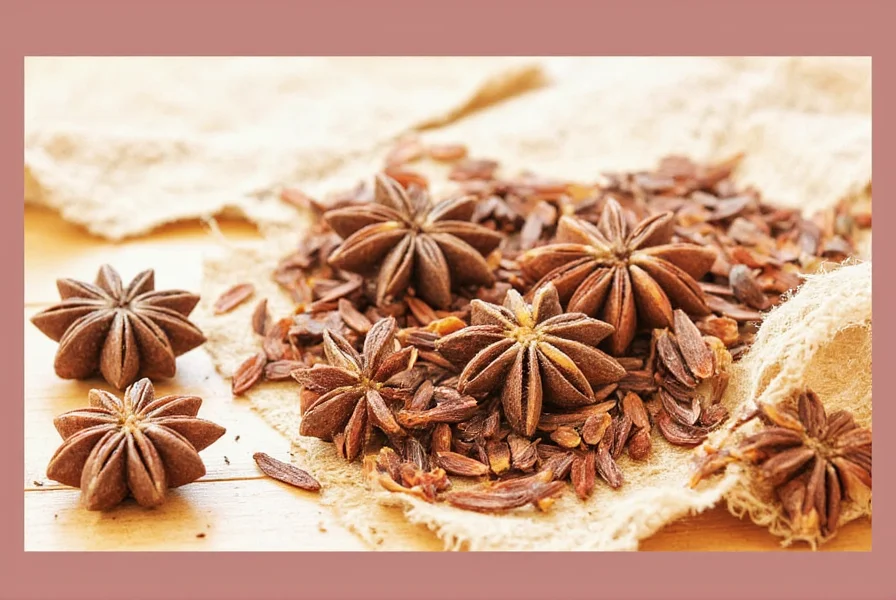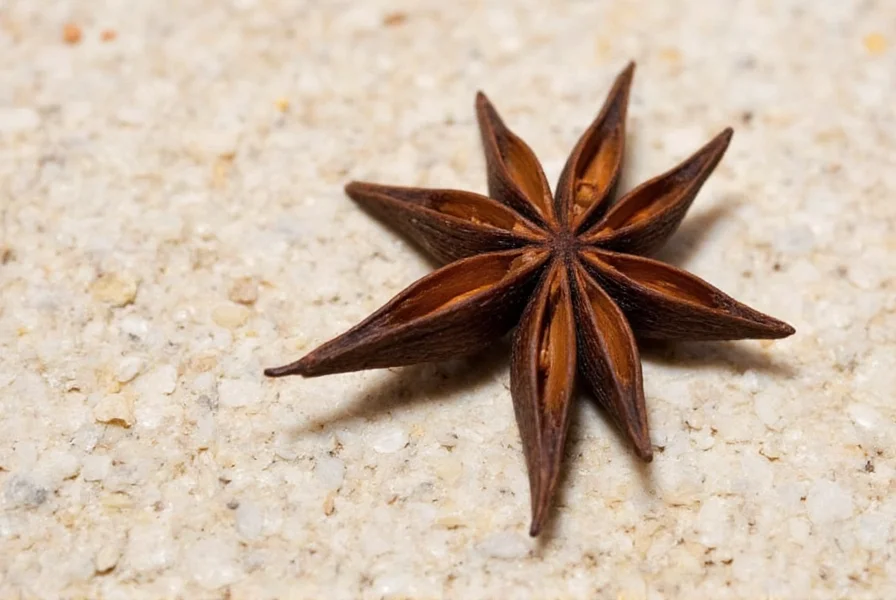Anis estrellado is the Spanish term for star anise, a distinctive star-shaped spice derived from the fruit of the Illicium verum tree. This aromatic spice features a potent licorice-like flavor and is widely used in Asian, Middle Eastern, and Latin American cuisines, as well as traditional medicine systems. Unlike regular anise (anis verde), which comes from a different plant species, anis estrellado contains the compound shikimic acid, making it valuable for both culinary applications and pharmaceutical production.
Star anise, known as anis estrellado throughout Spanish-speaking regions, has been prized for centuries across multiple cultures for its unique flavor profile and therapeutic properties. This distinctive spice originates from the evergreen Illicium verum tree native to西南 China and Vietnam, where it has been cultivated for over 3,000 years. The name "estrellado" (meaning "starred") perfectly describes its characteristic eight-pointed star shape, with each point containing a single seed that holds the most concentrated flavor.
Understanding the botanical characteristics of anis estrellado helps distinguish it from similar spices. While regular anise (Pimpinella anisum) belongs to the Apiaceae family (carrot family), star anise comes from the Schisandraceae family. This botanical difference explains why anis estrellado maintains its flavor intensity through prolonged cooking, making it ideal for slow-simmered dishes like Chinese five-spice powder, Vietnamese pho broth, and Indian biryani recipes. The spice's primary flavor compound, anethole, gives it that signature licorice taste that enhances both sweet and savory preparations.
| Characteristic | Anis Estrellado (Star Anise) | Anis Verde (Regular Anise) |
|---|---|---|
| Botanical Name | Illicium verum | Pimpinella anisum |
| Plant Family | Schisandraceae | Apiaceae |
| Origin | China, Vietnam | Mediterranean region |
| Form | Whole star-shaped fruit | Small oval seeds |
| Heat Stability | Retains flavor during long cooking | Loses flavor with prolonged heat |
The global culinary applications of anis estrellado demonstrate its remarkable versatility. In Chinese cuisine, it's one of the five essential spices in the famous five-spice powder blend. Vietnamese cooks rely on this spice as a fundamental ingredient in pho broth, where it simmers for hours to develop complex flavors. Mexican and Central American kitchens incorporate anis estrellado into traditional mole sauces and certain coffee preparations. The spice also features prominently in Indian garam masala blends and Middle Eastern meat rubs. Professional chefs particularly value anis estrellado for its ability to infuse dishes with deep, complex flavor that withstands extended cooking times without diminishing.

Beyond the kitchen, anis estrellado plays a significant role in traditional medicine systems worldwide. Traditional Chinese Medicine practitioners have used star anise for centuries to address digestive issues, respiratory conditions, and to promote circulation. The spice contains shikimic acid, a crucial component in the production of oseltamivir (Tamiflu), an antiviral medication. Modern research suggests potential benefits including antioxidant properties, anti-inflammatory effects, and antimicrobial activity. However, it's essential to note that Japanese star anise (Illicium anisatum) is toxic and should never be consumed, highlighting the importance of sourcing authentic anis estrellado from reputable suppliers.
When incorporating anis estrellado into your cooking, proper usage techniques maximize its flavor potential. Whole pods work best for slow-cooked dishes, as they gradually release their aromatic compounds. For quicker preparations, ground star anise provides immediate flavor but loses potency faster. A single whole star anise pod typically flavors one cup of liquid, making it easy to scale recipes. To preserve freshness, store whole anis estrellado in an airtight container away from light and heat, where it will maintain optimal flavor for up to two years. Ground star anise retains quality for only 6-8 months, so purchasing whole pods and grinding them as needed delivers superior results.
Safety considerations are important when using anis estrellado. While generally recognized as safe for culinary use, excessive consumption may cause adverse effects due to its potent compounds. Pregnant women should consult healthcare providers before using star anise medicinally, as it may affect hormone levels. The spice contains anethole, which in large quantities can be neurotoxic. Always ensure you're using authentic Chinese star anise (Illicium verum) rather than the toxic Japanese variety. When purchasing, look for deep reddish-brown pods with a strong, sweet aroma—dull or musty-smelling pods indicate poor quality or age.

Understanding the distinction between anis estrellado and similar spices prevents culinary mistakes. Many people confuse star anise with regular anise (anis verde) or fennel seeds, but each offers unique flavor profiles and cooking properties. While regular anise seeds work well in baked goods and quick preparations, anis estrellado's heat stability makes it indispensable for long-simmered dishes. The flavor intensity also differs significantly—star anise delivers a more potent licorice note that requires careful measurement in recipes. When substituting between these spices, use approximately 1.5 star anise pods for every teaspoon of regular anise seeds to achieve comparable flavor intensity.
For home cooks exploring anis estrellado, several practical applications showcase its versatility. Add one whole pod to poaching liquid for pears or apples to create elegant desserts. Infuse it in simple syrup for cocktails with distinctive flavor. Include it in homemade chai tea blends for added complexity. Use it in braising liquids for meats to develop rich, layered flavors. Create a fragrant rice pilaf by adding a pod to the cooking liquid. The spice also works beautifully in fruit compotes and jams, where its flavor complements stone fruits and berries. Remember to remove whole pods before serving, as they remain hard and inedible even after prolonged cooking.
What is the difference between anis estrellado and regular anise?
Anis estrellado (star anise) comes from the Illicium verum tree and has a star-shaped fruit with eight points, while regular anise (anis verde) comes from the Pimpinella anisum plant and produces small oval seeds. Star anise has a more intense, slightly sharper licorice flavor that holds up better during long cooking times compared to regular anise.
Can I substitute anis estrellado for regular anise in recipes?
Yes, but with careful adjustment. Use approximately 1.5 whole star anise pods for every teaspoon of regular anise seeds. Remember that star anise has a stronger flavor and works best in slow-cooked dishes, while regular anise is better for quick preparations and baking. Always remove whole star anise pods before serving.
What are the main culinary uses of anis estrellado?
Anis estrellado is essential in Chinese five-spice powder, Vietnamese pho broth, Indian garam masala, and Mexican mole sauces. It's used in slow-cooked dishes, braises, stews, poaching liquids for fruits, chai tea blends, and certain baked goods. Its heat stability makes it ideal for recipes requiring long simmering times.
Is anis estrellado safe to consume regularly?
Anis estrellado is safe when used in normal culinary amounts. However, excessive consumption may cause adverse effects due to its potent compounds. Pregnant women should consult healthcare providers before medicinal use. Always ensure you're using authentic Chinese star anise (Illicium verum), not the toxic Japanese variety (Illicium anisatum).
How should I store anis estrellado to maintain freshness?
Store whole anis estrellado pods in an airtight container away from light, heat, and moisture. Properly stored, whole pods retain optimal flavor for up to two years. Ground star anise loses potency more quickly and should be used within 6-8 months. For best results, purchase whole pods and grind them as needed.











 浙公网安备
33010002000092号
浙公网安备
33010002000092号 浙B2-20120091-4
浙B2-20120091-4